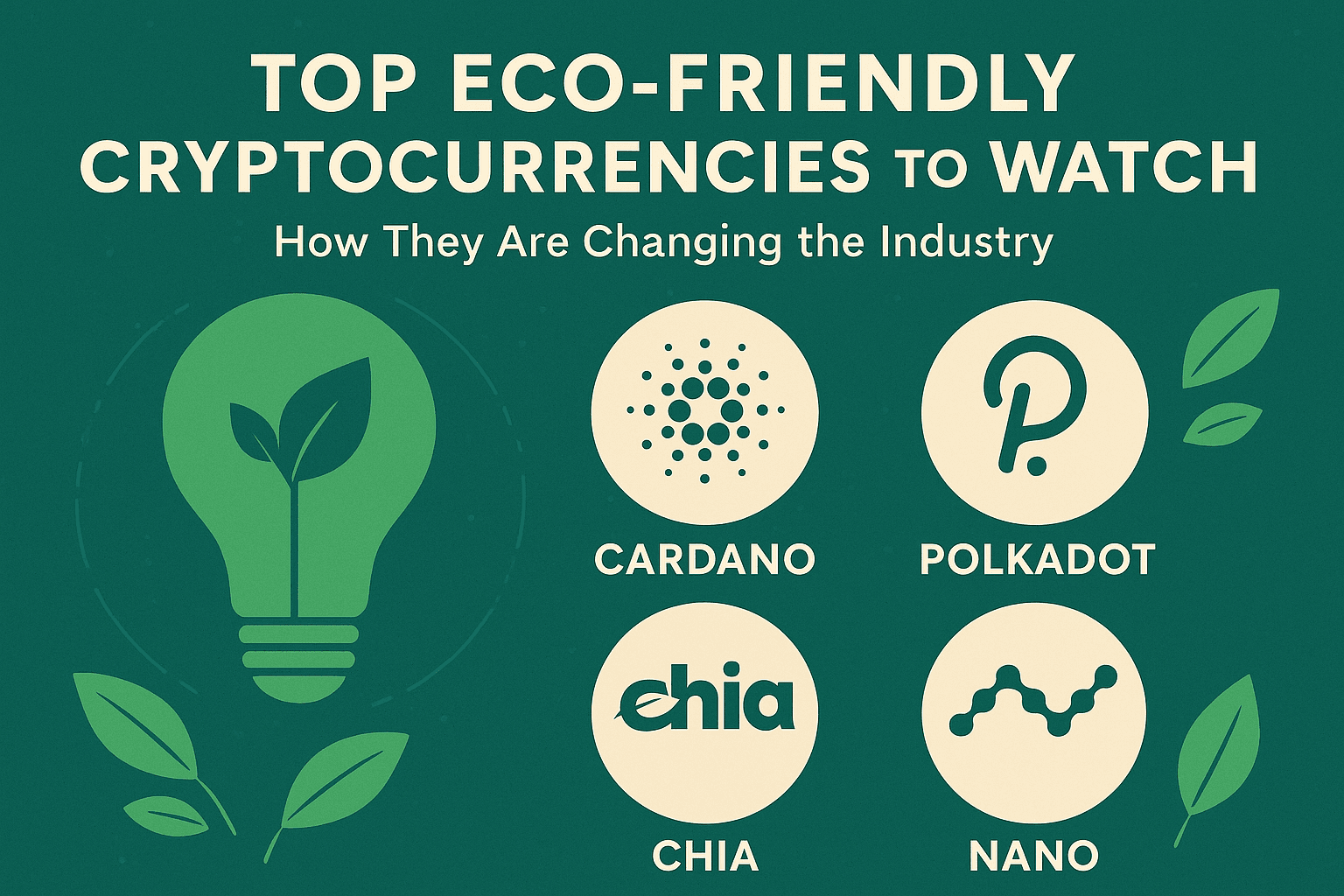Introduction
The cryptocurrency industry has faced criticism for its significant environmental impact, particularly due to the energy-intensive nature of Proof of Work (PoW) mining. However, as the world becomes increasingly focused on sustainability, a new wave of eco-friendly cryptocurrencies is emerging. These projects aim to reduce the carbon footprint associated with blockchain technology by adopting energy-efficient consensus mechanisms, utilizing renewable energy, and implementing green initiatives. In this article, we will explore the top eco-friendly cryptocurrencies to watch in 2025 and how they are transforming the industry.

1. Chia Network
Consensus Mechanism: Proof of Space and Time
Chia Network is one of the most innovative eco-friendly cryptocurrencies, utilizing a consensus mechanism called Proof of Space and Time. Unlike traditional PoW, which requires vast amounts of computational power, Chia leverages unused hard drive space, making it significantly more energy-efficient.
- Sustainability Focus: By reducing the need for energy-intensive mining operations, Chia drastically lowers its carbon footprint.
- Adoption and Growth: Chia has gained considerable attention in the crypto community for its environmental approach, with more individuals and businesses exploring its potential.
2. Algorand
Consensus Mechanism: Pure Proof of Stake (PPoS)
Algorand is another leading green cryptocurrency, operating on a Pure Proof of Stake (PPoS) consensus mechanism. This method is inherently energy-efficient as it doesn’t rely on mining but instead selects validators based on their stake in the network.
- Carbon-Neutral Blockchain: Algorand has committed to being carbon-neutral, partnering with environmental organizations to offset its emissions.
- Scalability and Efficiency: In addition to its green credentials, Algorand is known for its fast transaction times and low fees, making it a viable option for a wide range of applications.
3. Tezos
Consensus Mechanism: Liquid Proof of Stake (LPoS)
Tezos is a blockchain platform that uses Liquid Proof of Stake (LPoS), which, like other PoS mechanisms, is much less energy-intensive than PoW. Tezos is also recognized for its on-chain governance model, which allows the network to evolve and upgrade without requiring energy-intensive hard forks.
- Eco-Friendly Initiatives: Tezos has a strong focus on sustainability and has been involved in various green initiatives, including partnerships with carbon offset organizations.
- Innovation and Adaptability: The platform’s self-amending protocol ensures that it remains adaptable and can continuously improve its environmental impact.
4. Cardano
Consensus Mechanism: Ouroboros Proof of Stake
Cardano, known for its rigorous scientific approach to blockchain development, uses the Ouroboros Proof of Stake consensus mechanism. This protocol is designed to be highly energy-efficient, reducing the environmental impact compared to traditional PoW networks.
- Environmental Commitment: Cardano’s foundation has expressed a strong commitment to sustainability, including partnerships aimed at supporting green projects and reducing carbon emissions.
- Global Impact: Cardano is also focused on global challenges beyond the environment, including financial inclusion and decentralized governance.
5. Celo
Consensus Mechanism: Proof of Stake
Celo is a mobile-first blockchain platform that aims to create a more inclusive financial system. Its Proof of Stake consensus mechanism ensures that it operates in an energy-efficient manner, making it an eco-friendly alternative to traditional cryptocurrencies.
- Sustainable Mission: Celo is dedicated to building a financial system that creates conditions for prosperity while also being environmentally sustainable.
- Carbon Neutrality: The Celo platform has committed to being carbon-neutral, actively working to offset any emissions associated with its network.
6. Solana
Consensus Mechanism: Proof of History (PoH) combined with Proof of Stake (PoS)
Solana has gained significant attention for its high-speed transactions and low fees, but it also boasts a relatively low environmental impact due to its unique consensus mechanism, Proof of History (PoH), combined with Proof of Stake (PoS).
- Energy Efficiency: Solana’s approach reduces the need for intensive computational work, making it more environmentally friendly than traditional PoW networks.
- Growing Ecosystem: The Solana network is rapidly expanding, with a growing number of decentralized applications (dApps) and projects choosing to build on its platform.
Conclusion
As environmental concerns continue to shape the future of technology, the rise of eco-friendly cryptocurrencies represents a significant shift in the industry. These projects are not only addressing the scalability and efficiency challenges of blockchain technology but are also pioneering a more sustainable approach. By adopting energy-efficient consensus mechanisms, utilizing renewable energy, and committing to carbon neutrality, these green cryptocurrencies are setting the standard for the future of blockchain.
In 2025 and beyond, these eco-friendly projects are likely to play a crucial role in the continued evolution of the crypto industry, offering a more sustainable alternative to traditional cryptocurrencies and appealing to an increasingly environmentally conscious audience.


